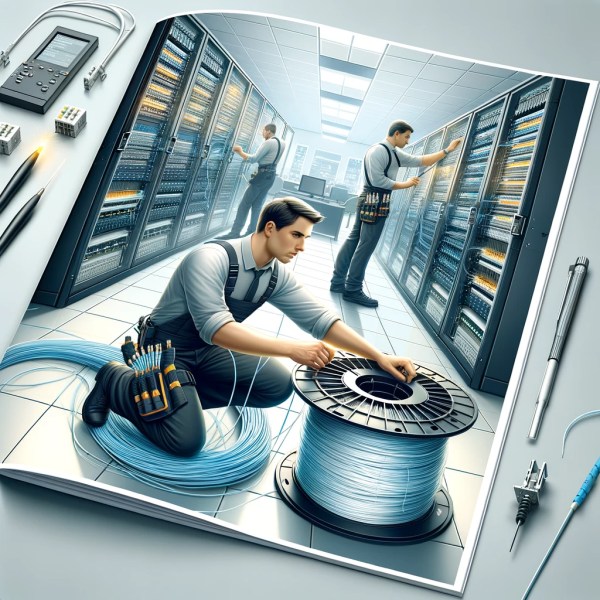Fiber Optic Cabling
Our high-speed, reliable data transmission is perfect for telecommunications, networking, and data center applications, giving your business the competitive edge it needs to succeed.


What is Fiber Optic Cabling?
A fiber optic cable is made of an extremely thin film of glass / plastic and uses pulse light to transmit data to offer increased bandwidth and speed to handle heavy volumes of data. The key components of a passive fiber optic network are: Backbone Fiber Cable, Pigtails, Patch Panels, and Fiber Patch Cords. The components are the same for a single mode or a multimode network.
Fiber Optic Services Offered
1. Fiber Cable Laying: Fiber cable laying is the foundational process of deploying fiber optic cables within a network infrastructure. This can involve several methods depending on the environment:
- Direct Burial: Cables are laid directly into the ground in trenches.
- Conduit Installation: Cables are routed through pre-installed conduits, offering protection from external elements.
- Aerial Installation: Cables are strung overhead, usually along existing utility poles.
2. OTDR Testing: Optical Time Domain Reflectometry (OTDR) testing is used to evaluate the integrity of fiber optic cables. It helps in identifying faults, measuring loss, and locating breaks or imperfections along the fiber optic cable.
3. Splicing Services:
Fiber optic splicing is the method of joining two fiber optic cables together. There are two types of splicing:
- Fusion Splicing: The most widely used method, where cable ends are precisely aligned and then welded together by an electric arc.
- Mechanical Splicing: This method physically holds the fibers together in alignment, usually used for temporary or emergency repairs.
4. Fiber Cable Trenching: digging trenches in which fiber optic cables can be laid. This is a crucial part of the deployment phase in fiber optic network installation, particularly for underground cabling systems.

Benefits of Fiber Optic Cabling

Faster data transmission
As per industry standards, while copper cables can effectively transmit data only up to 40 gigabits, fibre optics can transmit the same data at light speed and makes it easier for information to be transmitted.

Light weight
Fibre optics are extremely light weight with a diameter of human hair. Imagine the ease of layout it allows you to. Being lightweight, they are cheaper than their metallic counterparts.

No electrical and electromagnetic interference
Since they use light to transfer the data, there is zero electrical and electromagnetic interference; thus leading to faster transmission and less retransmission.

Large bandwidth
As the light arrays have a very high frequency in the GHz range, the optical fibre bandwidth is vast. This allows the transmission of more channels. Therefore, the information-carrying capacity of an optical fibre is much higher

Improved Data Transmission
Fiber optic cabling can transmit data at the speed of light, making transmitting information faster and more efficient. On the other hand, copper cables can transmit data up to 40 gigabits.

Light Weight
Fiber optic cable is quite lightweight and more economical than its metallic counterparts, like copper. It is just the diameter of human hair.
Industries We Cater To
Technology and IT
Data Centers, IT Service Providers, Software Development Companies
Finance
Banks and Financial Institutions, Insurance Companies, Fintech Companies
Real Estate
Commercial Real Estate Developers, Residential Complexes, Property Management Firms
Education
Schools and Universities, Online Education Platforms, Research Institutions
Retail
Shopping Centers and Malls, E-commerce Platforms, Retail Chains and Franchises
Healthcare
Hospitals and Clinics, Medical Research Facilities, Telemedicine Services,
FAQs
Fiber optic services refer to the installation, maintenance, and repair of fiber optic cables, which are used to transmit data at high speeds over long distances using light signals.
Fiber optic cables provide significantly higher speeds and bandwidth compared to traditional copper cables. They are also less susceptible to electromagnetic interference and can transmit data over longer distances without loss of signal quality.
Installation of fiber optic cables can involve trenching, laying cables in conduits, aerial installation, and ensuring proper connections and terminations at network interfaces and equipment.
Fiber splicing is the process of joining two fiber optic cables together. It is crucial for extending networks or repairing broken sections of cable. The two main types of splicing are mechanical splicing and fusion splicing.
Yes, damaged fiber optic cables can be repaired through careful splicing techniques. The damaged section is usually removed, and a new section of fiber is spliced in its place to restore the integrity of the communication line.
Optical Time-Domain Reflectometry (OTDR) testing is used to detect faults, measure loss, and assess the quality of fiber optic cables. It is typically performed after installation and for routine maintenance checks or after a repair to ensure that the fiber is functioning correctly.
Fiber optic cables are known for their longevity and can last 20 to 25 years or more, depending on environmental conditions and the quality of the installation.
Consider factors such as the provider’s experience, the range of services offered, the quality of materials used, customer service reputation, and the ability to scale services to meet future needs.
We are rated highly by our clients
It is a long established fact that a reader will be distracted by the readable content of a page when looking at its layout. The point of using Lorem Ipsum is that it has a more-or-less normal distribution of letters.
Our latest blogs
It is a long established fact that a reader will be distracted by the readable content of a page when looking at its layout. The point of using Lorem Ipsum is that it has a more-or-less normal distribution of letters.
Updated: May 13, 2024 In India, the data center industry has been growing rapidly, driven by an increase in digital data consumption,
Introduction In the realm of digital transformation, data centers and hyperscalers play pivotal roles. This blog explores what data centers are, their
CommScope’s expansion of its manufacturing plant in Goa, India, marks a strategic pivot aimed at bolstering its footprint in the burgeoning Asia-Pacific
Unshielded Twisted Pair (UTP) is a cornerstone in the construction of modern Ethernet networks and network cabling. It’s not only widely used









